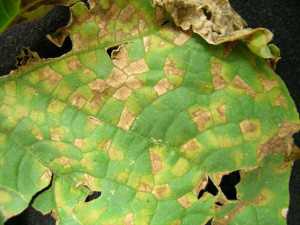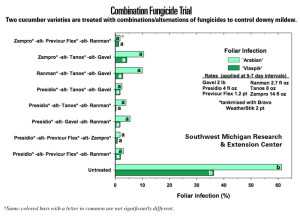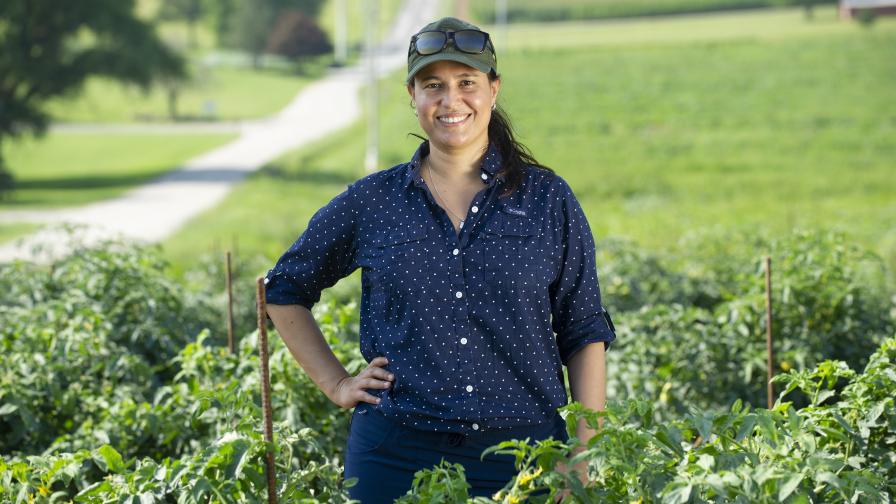Options To Control Downy Mildew In Cucumbers

Downy mildew is of critical concern for cucumber growers in mid-western regions, and is of particular concern to processing cucumber growers in Michigan, as the state is the top producer of the crop in the U.S.
Photo credit: Mary K. Hausbeck
Downy mildew, caused by the water mold, Pseudoperonospora cubensis, is of critical concern for growers in Midwestern regions. It is of particular concern to processing cucumber growers in Michigan, as the state is the top producer of the crop in the U.S.
Growers are at a disadvantage combating this disease because there are no resistant cucumber cultivars available. Fungicides have been the only effective means of controlling this disease. Despite fungicides being one of the only control methods, the pathogen is resistant to mefenoxam-based products and the strobilurin fungicides.
Research conducted by Mary K. Hausbeck and her team at Michigan State University (MSU) shows that there are effective fungicides, but they must be applied every five to seven days during periods of damp or wet weather.
Monitoring Via Spore Trapping
The downy mildew pathogen does not overwinter in the mid-western region. It reproduces via tiny, microscopic spores that act as seeds of the pathogen, and the spores travel on air currents from areas where they can overwinter, such as in Southern areas of the U.S. or protected cucumber production greenhouses.

A variety of products were tested in Michigan for the control of downy mildew in cucumbers.
To help growers determine the level of downy mildew threat, a monitoring system has been in place for Michigan since 2006 that includes spore trapping. In 2013, spore traps were placed in Monroe and Saginaw Counties, and continuously sampled the air and collected spores into the trap. These spores were embedded on a sticky film that was removed and taken to the laboratory.
A compound microscope was used to identify any downy mildew spores present on the tapes. The numbers of spores per day were uploaded to Hausbeck’s grower website, www.veggies.msu.edu.
The traps alert growers to any influx of spores into Michigan’s production regions, but are not the only tools used to time fungicide sprays. Every year the researchers trapped downy mildew, spores have been detected before the first case of disease was confirmed.
Overall, daily downy mildew spore counts in Monroe County were very low throughout the growing season with a peak in late June and early July approximately two weeks before the disease was confirmed in that county. In comparison, the downy mildew spore counts were much higher in Saginaw County later in the growing season and peaked in late July and early August. For both spore-trapping sites, low to moderate downy mildew spore numbers were detected by the traps several weeks prior to the confirmation of disease in each location.
Hausbeck’s website also features current Extension articles about downy mildew, fungicide recommendations, photos of downy-mildew infected cucurbits and look-alike diseases, and links to other websites. Those websites include the Enviro-Weather Vegetable Page (http://enviroweather.msu.edu/), which also has pest management recommendations for cucurbit downy mildew, and the Cucurbit Downy Mildew Forecast Homepage (http://cdm.ipmpipe.org/).
The goal of Hausbeck’s fungicide research is to ensure that cucumber growers will continue to have the most effective fungicide products available, and that they, along with allied industries, will know in advance whether previously effective strategies have remained durable or if alternative products or strategies are needed.
Trials Test For Efficacy At Low And High Rates

Mary Hausbeck and her team at the Michigan State University lab tested the fungicides (new and unregistered) for efficacy at low and high rates when applied alone or in a rotational program with other downy mildew fungicides.
Once natural infection by downy mildew was confirmed in Michigan in July 2013, fungicide field trials were planted at the Southwest Michigan Research and Extension Center in Berrien County. Trials were arranged in a randomized complete block design with four replicates. Sprays were initiated at first true leaf and fungicides were applied by broadcast foliar sprays directed to the foliage.
Hausbeck and her team at the MSU lab tested the fungicides (new and unregistered) for efficacy at low and high rates when applied alone or in a rotational program with other downy mildew fungicides. Fungicide Resistance Action Committee (FRAC) codes are used to determine the mode of action that the active ingredient has on the pathogen. (See Products Tested For Downy Mildew Control chart.)
A 17-treatment trial on Vlaspik, a cucumber variety from Seminis, included products applied alone at both a low and high rate. The untreated control plots showed a foliar downy mildew incidence of nearly 75%, whereas a new experimental fungicide completely prevented the disease. Overall, the weather in the Berrien County area was drier than other areas of the state and irrigation was needed. (See 17-Treatment Trial On Vlaspik chart.)

The goal of Michigan State researcher Mary Hausbeck’s fungicide research is to ensure that cucumber growers will continue to have the most effective fungicide products available.
Another trial was established in Berrien County where the varieties Vlaspik and Arabian (also from Seminis) were treated with combinations/alternations of fungicides for downy mildew control. Results from this plot answer the questions that growers often ask, including which fungicide program is preferred and/or most (cost) effective. In this trial, downy mildew in the untreated control plot was at about 60% for Vlaspik and 35% for Arabian.
All fungicide treatment programs effectively limited downy mildew compared to the untreated control. Each downy mildew fungicide was tank mixed with Bravo Weather Stik (Syngenta Crop Protection) according to recommendations, and the fungicide programs that included Presidio (Valent U.S.A.) limited downy mildew to less than 8%. All other fungicide treatments showed some level of downy mildew with all treatments keeping disease to less than 11%. (See Combination Fungicide Trial chart.)
Editor’s Note: Mary K. Hausbeck, a professor and Extension specialist in the Plant, Soil and Microbial Sciences Department at Michigan State University contributed this article ([email protected]). The research was supported by funding provided by the Agricultural Research Fund, Pickle Packers International, Inc., the Pickle and Pepper Research Committee, Pickle Packers International, Inc., and by Project GREEEN GR12-020.










